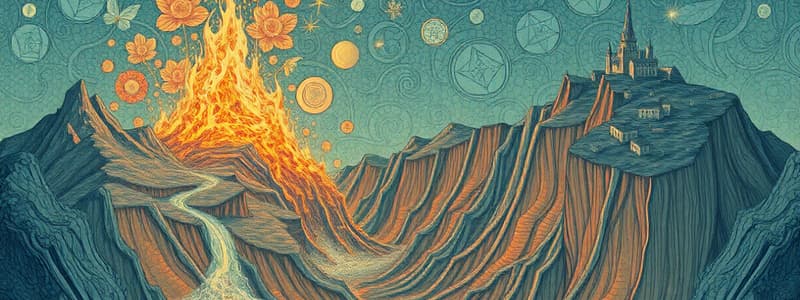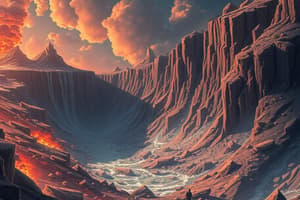Podcast
Questions and Answers
What is the primary cause of earthquakes?
What is the primary cause of earthquakes?
- Melting of polar ice caps
- Over-saturation of soil and rock
- Chemical reactions in the earth's core
- Release of energy along geological faults (correct)
What defines a landslide?
What defines a landslide?
- Sudden shaking of the ground
- Collapse of underground caves
- Downward movement of earth or rocks under gravity (correct)
- Formation of depressions in the earth's surface
What geological hazard is characterized by depressions formed when the surface layer collapses?
What geological hazard is characterized by depressions formed when the surface layer collapses?
- Avalanches
- Earthquakes
- Mudslides
- Sinkholes (correct)
Which of the following situations can trigger a landslide?
Which of the following situations can trigger a landslide?
The 1994 Northridge earthquake had a magnitude of what?
The 1994 Northridge earthquake had a magnitude of what?
Which geological hazard can cause damage due to the collapse of soluble bedrock?
Which geological hazard can cause damage due to the collapse of soluble bedrock?
In which event did the Oso landslide occur, resulting in the loss of 43 lives?
In which event did the Oso landslide occur, resulting in the loss of 43 lives?
What type of hazards are associated with seismic activity apart from earthquakes?
What type of hazards are associated with seismic activity apart from earthquakes?
Earthquakes are caused by the release of energy along geological faults or tectonic plate boundaries.
Earthquakes are caused by the release of energy along geological faults or tectonic plate boundaries.
The Oso landslide in 2014 resulted in the deaths of 43 people and was significantly influenced by rainfall.
The Oso landslide in 2014 resulted in the deaths of 43 people and was significantly influenced by rainfall.
Sinkholes occur primarily due to the movement of solid granite layers beneath the surface.
Sinkholes occur primarily due to the movement of solid granite layers beneath the surface.
The epicenter of an earthquake is the point directly above where the earthquake starts.
The epicenter of an earthquake is the point directly above where the earthquake starts.
Seismically-triggered landslides are a type of geological hazard related to rainfall.
Seismically-triggered landslides are a type of geological hazard related to rainfall.
In 1994, the Northridge earthquake had a magnitude of 6.7.
In 1994, the Northridge earthquake had a magnitude of 6.7.
Landslides can occur without the presence of gravity.
Landslides can occur without the presence of gravity.
Soil saturation can contribute to the risk of landslides.
Soil saturation can contribute to the risk of landslides.
The sinkhole that opened in Guatemala City in 2010 resulted in more than 20 casualties.
The sinkhole that opened in Guatemala City in 2010 resulted in more than 20 casualties.
Tsunamis are classified solely as seismic hazards related to earthquakes.
Tsunamis are classified solely as seismic hazards related to earthquakes.
Flashcards are hidden until you start studying
Study Notes
Earthquakes
- A sudden shaking of the ground caused by the release of energy along geological faults or tectonic plate boundaries.
- The epicenter is the point on the Earth's surface directly above where an earthquake starts.
- The 1994 Northridge earthquake in California had a magnitude of 6.7, resulted in 57 deaths, and caused $60 billion in damages (in 2013 dollars).
Landslides
- The downward movement of rock, earth, or debris, usually under the influence of gravity.
- A large landslide in 2014 at Oso, Washington, killed 43 people and covered a valley with at least 20 feet of debris.
- Both government and insurance companies refused to pay claims for the 2014 landslide.
Sinkholes
- Depressions or holes that form when the surface layer collapses.
- Typically occur where the subsurface layer is made of soluble bedrock (like limestone) that can be dissolved by water.
- A sinkhole opened in Guatemala City in 2010, taking out a café and resulting in at least 20 casualties.
Landslides Induced by Rainfall
- Occur when soil becomes over-saturated and cannot hold together.
- Rainfall can cause landslides by saturating the soil, increasing its weight, and making it prone to slippage.
- Experts warn of the danger of landslides after heavy rains.
Seismic Hazards
- Ground rupture/faulting: Direct displacement of the Earth's surface along a fault.
- Liquefaction: The transformation of solid ground into a fluid-like state due to seismic shaking.
- Strong motion: The shaking of the ground during an earthquake.
- Tsunami: A giant wave caused by a sudden displacement of water, often triggered by an earthquake.
Other Geohazards
- Various landslide types, including:
- Seismically-triggered landslides
- Debris flows
- Mud flows
- Rock falls
- Mineral hazards:
- Asbestos
- Radon
- Mercury
Earthquakes
- Earthquakes are sudden ground movements caused by energy release along geological faults or tectonic plate boundaries.
- The epicenter, the earthquake's starting point, is directly below the point on the Earth's surface where the shaking is felt.
- The 1994 Northridge earthquake in California had a magnitude of 6.7, resulted in 57 deaths, and caused $60 billion in damages (in 2013 dollars).
Landslides
- Landslides are downward movements of rock, earth, or debris, typically driven by gravity.
- A major landslide in Oso, Washington in 2014 killed 43 people and covered a valley with at least 20 feet of debris.
- Both government and insurance companies denied claims related to the 2014 landslide.
Sinkholes
- Sinkholes are depressions or holes formed when the surface layer collapses.
- They often occur in areas with soluble bedrock, like limestone, that can be dissolved by water.
- A sinkhole in Guatemala City in 2010 swallowed a café, resulting in at least 20 casualties.
Landslides Induced by Rainfall
- Heavy rainfall can oversaturate soil, causing it to lose stability and lead to landslides.
- Landslides can involve various materials, including soil, rock, and debris.
- Experts warn of the danger of landslides following prolonged heavy rain.
Seismic Hazards
- Earthquakes can trigger various seismic hazards, including ground rupture/faulting, liquefaction, strong motion, and tsunamis.
Landslide Types
- Landslides can be triggered by seismic activity and include debris flows, mud flows, and rock falls.
Mineral Hazards
- Certain minerals, such as asbestos, radon, and mercury, pose geological hazards.
Studying That Suits You
Use AI to generate personalized quizzes and flashcards to suit your learning preferences.




